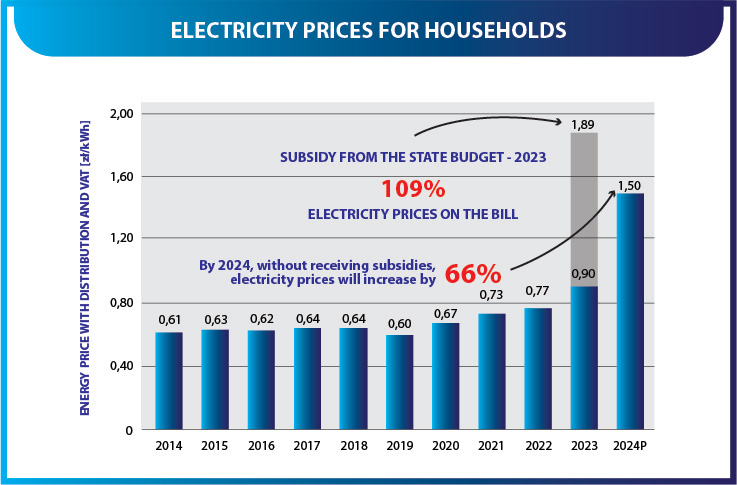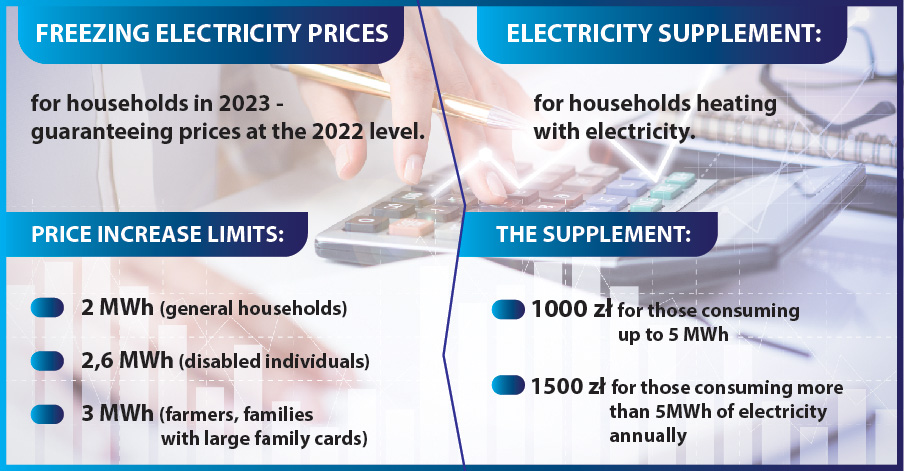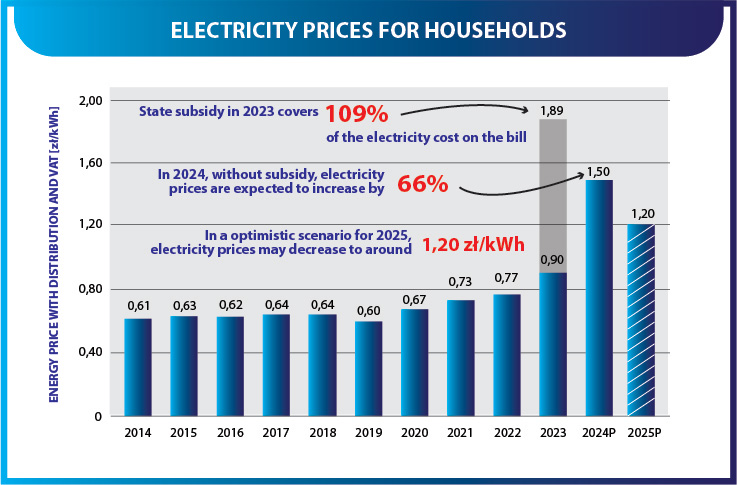
Electricity
ELECTRICITY PRICES
Electricity prices are expected to increase year by year, affecting both households and businesses.

In the case of a 10% reduction in energy consumption from the fall of 2022 to the end of 2023, prices in 2024 could be lower by 10% in all tariffs and zones for households, businesses, and institutions. This obligation is stipulated in the “freezing” law.
Households that consume no more than 90% of the energy in 2023 compared to 2022 will receive a special discount of 10% of the total costs of electricity consumption in 2023. This rewards energy conservation.

The “Freezing” Law, adopted by the Sejm on October 7, 2022, envisions freezing electricity prices in 2023 as part of the so-called Solidarity Shield. The new regulations will prevent an increase in energy costs for most Polish families. They will not pay higher electricity bills up to the limit of 2,000 kilowatt-hours (kWh). A higher limit of 2,600 kWh will apply to people with disabilities, and a limit of 3,000 kWh for families with the Large Family Card and farmers. A special electric supplement will also be introduced for households that use electricity for heating, including those using heat pumps.

In 2023, three different electricity prices apply:
A tariff approved by the President of the Energy Regulatory Office, amounting to 1.05 PLN/kWh net (PGE, Enea, Tauron, and Energa rates vary slightly). This tariff is for electricity alone, to which a distribution tariff of 0.47 PLN and 35 PLN VAT must be added. In total, this year, we pay 1.89 PLN/kWh gross for electricity. However, less than half of this amount is visible on the electricity bill, as most of it is financed by the state.
The highest rate for electricity for households is 69.3 PLN (with excise duty 69.8 PLN plus VAT). According to the “price freeze” law, domestic consumers cannot pay more for electricity alone this year. In reality, this rate is seen on bills by consumers who exceed the statutory limits of electricity consumption (for most families, it’s 3,000 kWh/year). This rate applies both day and night and is over 130% higher than in 2022. After adding distribution costs, heating costs in the night zone have increased by 78% to nearly 99 PLN/kWh gross this year.
“Frozen” rates for electricity up to a limit of 3,000 kWh of annual consumption. These are the same rates we saw on bills in 2022, increased by excise tax and higher VAT. A larger portion of households will pay only this rate this year. In the most popular G11 tariff (all-day), it amounts to 0.41 PLN/kWh for electricity alone, 0.32 PLN/kWh for distribution, and 0.17 PLN/kWh for VAT. Therefore, this year, most of us will pay 0.90 PLN/kWh gross for electricity. This is considerably more than 0.77 PLN/kWh in 2022 but over half less than we would pay without frozen prices.

The energy market has been organized in such a way that energy produced by units with the lowest variable production cost enters the power system first, following the “merit order” principle. Renewable energy sources (RES) provide the cheapest energy. As the demand for electricity increases, more expensive production units, such as coal and gas-fired plants, are engaged to meet market needs. Conversely, with lower demand, fewer working power blocks are required. Therefore, according to market principles, electricity is cheapest when demand is lowest, and prices rise with increasing demand as additional power plants are integrated into the system.
The market price of energy is dynamically determined by the most expensive unit operating in the system, known as the “marginal cost.” Energy during peak demand periods is thus more expensive than during off-peak periods. Conventional power plants (coal and gas-fired) can adjust their production to demand and market conditions within their technical capabilities. The supply of electricity from renewable sources depends solely on atmospheric conditions. When there is no sunlight or wind, RES in Poland cease to generate electricity, necessitating the substitution by coal and gas-fired power plants.
Renewable energy sources are the cheapest units generating electricity on the Polish market. While their investment costs are relatively high, their variable production cost remains the lowest. Comparatively more expensive units include those fueled by brown and hard coal, peak pump-storage power plants, which also function as energy storage, and gas-fired units, where the average production cost is currently the highest.
High production costs of electricity from hard coal and gas are influenced by both record-high prices of these raw materials and the costs of purchasing carbon dioxide emission rights in the EU ETS system.
Thanks to the marginal cost mechanism throughout the European Union, renewable energy sources are promoted. Although their operation depends on favorable weather conditions, they are becoming a more profitable investment. Nuclear energy also gains profitability despite the associated investment costs. Incorporating the costs of producing the most expensive units into the system ensures their continued profitability and is crucial for ensuring energy security until coal-fired power plants are replaced by nuclear and renewable sources.







